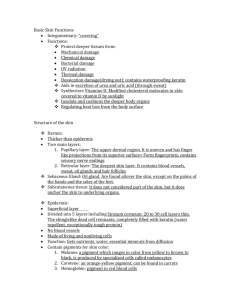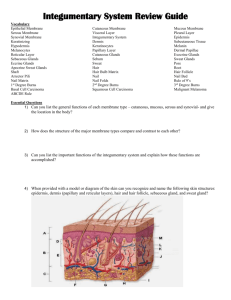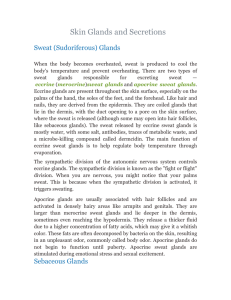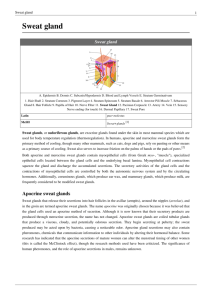Skin - it's all over you!
advertisement
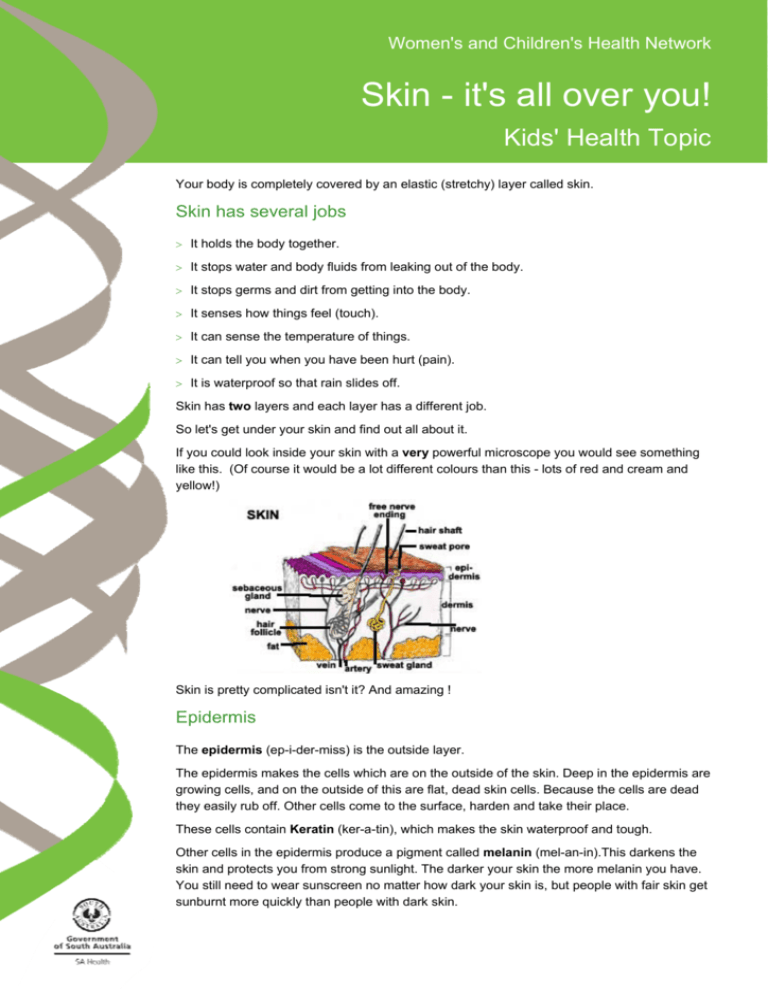
Women's and Children's Health Network Skin - it's all over you! Kids' Health Topic Your body is completely covered by an elastic (stretchy) layer called skin. Skin has several jobs It holds the body together. It stops water and body fluids from leaking out of the body. It stops germs and dirt from getting into the body. It senses how things feel (touch). It can sense the temperature of things. It can tell you when you have been hurt (pain). It is waterproof so that rain slides off. Skin has two layers and each layer has a different job. So let's get under your skin and find out all about it. If you could look inside your skin with a very powerful microscope you would see something like this. (Of course it would be a lot different colours than this - lots of red and cream and yellow!) Skin is pretty complicated isn't it? And amazing ! Epidermis The epidermis (ep-i-der-miss) is the outside layer. The epidermis makes the cells which are on the outside of the skin. Deep in the epidermis are growing cells, and on the outside of this are flat, dead skin cells. Because the cells are dead they easily rub off. Other cells come to the surface, harden and take their place. These cells contain Keratin (ker-a-tin), which makes the skin waterproof and tough. Other cells in the epidermis produce a pigment called melanin (mel-an-in).This darkens the skin and protects you from strong sunlight. The darker your skin the more melanin you have. You still need to wear sunscreen no matter how dark your skin is, but people with fair skin get sunburnt more quickly than people with dark skin. Dermis The dermis (der-miss) is a thicker and more elastic (stretchy) layer. In this layer there are: glands hair follicles nerves blood vessels. Glands You have two types of glands. Sebaceous glands (seb-ay-shus) produce sebum, a kind of oil, which helps keep your skin soft and waterproof. (I know you can get your skin wet but the water can't get inside your skin.) Sweat glands send sweat through pores (tiny holes) to the surface of the skin. When your body gets hot, the sweat glands make a lot of sweat which they send to the surface of your skin to cool you down. Hair follicles Hair covers most of your body (except your lips, the palms of your hands and the soles of your feet). The hair is made in the dermis in the hair follicles (foll-i-culs). Hair follicles look like tiny bulbs from which your hair grows. Most of the hair on your body is short and fine. Nerves Tiny networks of nerves act as sensors to let us feel the world around us. They tell us the temperature around us, make us feel pain if something hurts our skin and let us feel how smooth or rough things are and how hard our skin is being pressed. Blood vessels Blood vessels carry oxygen and nutrients (food) to the cells and carry away the waste. The Subcutaneous (sub-cute-ay-nee-us) layer is under the skin. It is mostly made up of fat. Fat acts as a cushion to protect your body if you bang into something. It also keeps you warm. Keeping you warm or cool When your body gets too hot Blood vessels widen to bring heat to the surface of your body. Sweat glands send sweat up to cool down the skin's surface. Hairs lie flat on your skin so that they don't trap any warm air (which would make you feel hotter.) _____________________________________________________________________ -2http://www.kids.cyh.com Last updated: February 2011 When your body gets too cold Blood vessels narrow so that you keep warmer inside. Sweat glands don't send sweat to the surface. Hairs stand up straight to trap a warm layer of air next to your skin. When you are cold (or frightened) your skin gets "goose bumps". These are made by tiny muscles pulling your hairs to make them stand up straight. How does your body know what to do? Remember that your skin can sense temperature? Well, the nerves in your skin send a message to the hypothalamus (hypo-thal-am-us) in your brain and back comes the signal to swing into action. The hypothalamus is in charge of keeping your body's core temperature at the right level (around 37°C or 98°F). Types of skin Look at your body and you will see that your skin looks different in different places. Skin is not the same thickness all over your body. On most of your body the skin is around 2mm thick. On the soles of your feet it is much thicker, while on your eyelids it is only 0.5mm thick. 1. I wonder if you can guess why the skin on your soles is so thick? Skin does not have the same form everywhere. Look at the skin around your elbows and knees. You will see that it is much looser than the skin on the rest of your arm or leg. 2. Why do you think this is so? The skin on the palm of your hand is much firmer than the skin on the back of your hand. 3. Can you think why it needs to be? (go to the last page to see if you were right) Did you know? You have around 100,000 hairs on your head. You lose skin cells all the time even when you are not moving around. A lot of household dust is dead skin cells. No-one has exactly the same fingerprints as anyone else. Something to do Paint your thumb with a thin layer of poster paint (which will wash off in water). On a clean sheet of paper print your thumbprint by pressing down and rolling your thumb sideways. Get your friend to do the same. _____________________________________________________________________ -3http://www.kids.cyh.com Last updated: February 2011 Check to see how your thumbprints compare. Why not write a story and use your thumbprint to illustrate it? You can add arms and legs, a mouth and eyes to turn your thumbprint into a cartoon character. Why not make a cartoon story? Your skin really cares for you. Make sure you care for your skin. Skin Skin Skin keeps you warm when it's cold And cool when it's hot. Skin is clever Even if you're not. Just be aware When you're in the sun. Put on sunscreen And have some fun. Jemma My body is all covered With lots of stretchy skin. My skin will grow up with me If I'm fat or if I'm thin. I'm glad my skin's around me. Just think how it would be, If all my skin came off one day. And you saw the 'inside' of me! BH S - Sensitive K - Kissable I - Important N - Naked and natural Adam and Dana Dr Kim says: "Skin is very strong and colourful. At least the English language thinks so. We are said to go white with shock, red with anger and green when we feel sick". What's wrong with a girl who has a blue face? Why, she's feeling blue of course! Can you think of any more colours that our skin is supposed to turn when we have different feelings? Were you right? 1. The skin on your soles needs to be thick because it gets rubbed a lot when you're moving around, and would wear out too fast otherwise. 2. The skin over your knees and elbows has to do a lot of stretching when you move. 3. The skin on your palms needs to be firm as you use your hands to grasp things. _____________________________________________________________________ -4http://www.kids.cyh.com Last updated: February 2011


